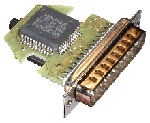MP3 Jukebox
About
Current Progress
Construction
Software
Photos
|
 |
|
| |
|
Introduction
This is my current project which I'm working on in my spare time. It's an MP3 player for a Hi-Fi separates system which I'm building using mostly second-hand parts, an Amiga motherboard, and some custom hardware and software of my own design. The idea is to store my MP3s on this unit in the living room with my hi-fi, and to be able to turn it on, quickly find and play any song via a remote, and to be able to add songs to its internal hard drive easily via CD or over a network from another computer. Read on to learn about the background of this unusual system...
|

|
|
 |
|
| |
|
In the Beginning...
Well, this all started a few years back, when I decided it would be nice to have all my MP3s accessible on my separates Hi-Fi system without having to start up my computer. Personal MP3 players (iPods and the like) were available, and of course I could just get one of these units and plug it into my stereo, but that didn't cut it for me. I had heard of a couple of custom projects, but usually they involved a PC of some description, and that's no better than using my PC, so why bother? It has long start-up times, it's noisy and bulky unless you go for the specialist (read: expensive) miniature system components, and it needs to be shut down.
 Around this time, a bright spark by the name of Dirk Conrad (his homepage) wrote some software for the Amiga which used an external MPEG decoder chip called the MAS3507D to decode MP3s at full quality without requiring the processor power that this would normally take. He also designed a small PCB to carry the chip and supporting components so that it could simply plug into an Amiga's parallel port and produce a normal line level audio out signal, and wrote two types of driver for it which enabled most MP3 playing software to use it. This device was christened the MAS Player... Just the ticket!
Around this time, a bright spark by the name of Dirk Conrad (his homepage) wrote some software for the Amiga which used an external MPEG decoder chip called the MAS3507D to decode MP3s at full quality without requiring the processor power that this would normally take. He also designed a small PCB to carry the chip and supporting components so that it could simply plug into an Amiga's parallel port and produce a normal line level audio out signal, and wrote two types of driver for it which enabled most MP3 playing software to use it. This device was christened the MAS Player... Just the ticket!
The Idea Forms
This got me thinking: The Amiga is the perfect choice for me for several reasons:
- I'm an Amiga fan, and so had plenty of experience tinkering with these machines.
- The Amiga hardware at a basic level is really suited to this type of task - no fans required, modest power requirements and plenty of interfacing options.
- The Amiga OS is wonderfully light, meaning on a modest machine with little more than a hard drive added, it can boot in less than ten seconds, doesn't need shutting down, and only access the hard drive when it's actually reading or writing a file. There's none of this constant disk churning due to the OS or applications not requiring virtual memory, and all system libraries are either ROM-based or pre-loaded at boot time.
- I had previously written software and built hardware for the Amiga, so I was confident I could give it a good shot.
- And finally, I had a couple of them lying around spare, so didn't have to go buying too much stuff :)
|

|
|
|




